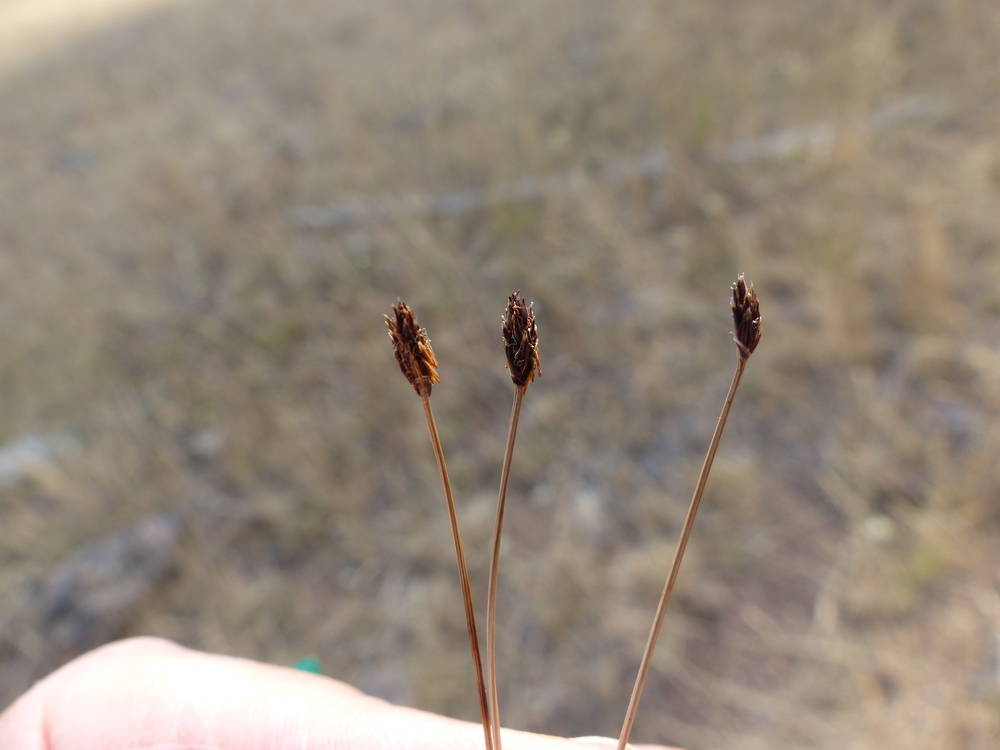Eleocharis bolanderi
Eleocharis ovata
Bolander's spikerush
ovoid spikerush
subterete, 10–30 cm × 0.3–0.5 mm.
terete, 2–35 cm × 0.3–1 mm.
ovoid, 3–8 × 2–3 mm;
proximal scale clasping; entire, subproximal scale with flower; floral scales 8–30, 4–5 per mm of rachilla, 2–3 × 1.5 mm;
apex entire; acute, often keeled in distal part of spike.
ovoid, 2–8 × 2–4 mm; floral scales 25–100+, approximately 10 per mm of rachilla, 1.5–2 × 1 mm; midribs often keeled in distal part of spike;
apex rounded to subacute.
perianth bristles 3–6, often unequal; from rudimentary to 50% of achene length;
anthers 0.9–1.4 mm;
stigmas 3.
perianth bristles present, rarely absent; (5)6–7, exceeding tubercle;
stamens 2(3);
anthers 0.3 mm;
stigmas 2 or some 3.
slightly to greatly compressed-trigonous, rarely thickly lenticular, 0.9–1.2 × 0.65–0.8 mm.
biconvex or to 33% greatly compressed trigonous, 0.75–1 × 0.6–0.85 mm.
persistent, not splitting;
apex obtuse, rarely hardened, lacking a tooth.
persistent, apex of distal leaf sheath obtuse to acute; tooth to 0.2 mm.
flat to shallowly pyramidal; lower than wide, 0.1–0.3 × 0.4–0.65 mm.
deltoid, 0.3–0.5 × 0.3–0.5 mm, 60% to as high as wide, 33–67% as high and 50–75% as wide as achene.
=10.
Eleocharis bolanderi
Eleocharis ovata
Shallow, rocky, ephemeral streams. 1100–2100 m. BR, BW, Owy. CA, NV, ID; east to CO. Native.
Eleocharis bolanderi is easily recognized in summer when it forms masses of dry, brown, dormant and apparently dead culms in dry stream beds. It is easily pulled up to expose its cespitose habit. The virtually flat tubercles are particularly distinctive.
Freshwater shores exposed by seasonal low water levels, marshes, and disturbed wetlands. 100–1300 m. ECas, Sisk, WV. WA; north to British Columbia; northeastern North America. Native?
Pacific Northwest occurrences of E. ovata are disjunct from the species northeastern North American range. This may suggest that the species is introduced in Oregon. More research is needed.
Barbara Wilson, Richard Brainerd, Nick Otting
Barbara Wilson, Richard Brainerd, Nick Otting
- Local floras:
CA,
OR,
WA
- Local Web sites:
CalFlora,
CalPhotos,
Flora NW,
PNW Herbaria
WildflowerSearch
iNaturalist (observations)
USDA Plants Database
- LBJ Wildflower Center
- SEINet
- Plants of the World Online
- Encyclopedia of Life
- Wikipedia
- Google Image Search
- Local floras:
BC,
CA,
OR,
WA
- Local Web sites:
CalFlora,
CalPhotos,
Flora NW,
PNW Herbaria
WildflowerSearch
iNaturalist (observations)
USDA Plants Database
- LBJ Wildflower Center
- SEINet
- Plants of the World Online
- Encyclopedia of Life
- Wikipedia
- Google Image Search




